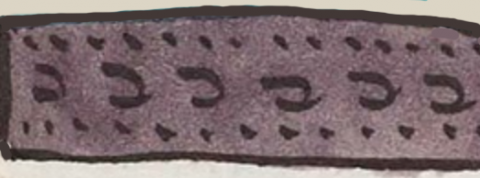tlalli (Mdz32r)
This element for land (tlalli) has been carved from the compound glyph for the place name Tlalatlauhco. It is a horizontal rectangle, colored purple, with rows of black dots along the top and bottom. Through the middle is a series of shapes (black line drawings) that look like the letter "U" tipped over or backward "c's." This sign comprises part of two different place name glyphs on the same folio, serving as an element in Tlalatlauhco and Tlallachco. In the latter example, we are able to see that the rows of dots and u's alternate. See also the attestations of tlalli in a range of examples of place names from elsewhere in the Codex Mendoza.
Stephanie Wood
The designs on the rectangle would likely be signs of agriculture. The term tlalli, which is found, for example, all across Nahuatl testaments from early Mexico, usually referred to an agricultural parcel, very similar to the term milli (which became milpa in contemporary Mexican Spanish). Some authors describe the C's as U's. Guarding against their being perceived as horse hoof-prints is the fact that they can be found in the glyph for atl tlachinolli (scorched earth) on a pre-Columbian stone carving. From the various attestations, we can see that tlalli can have alternating purple and orange segments, or it can be painted a continuous purple. Do the alternating colors suggest parcelization? The tlalli can also appear with other colors, such as we show in the example of the yellow land that comprises part of the place name for Tlalcozauhtitlan. Barbara Mundy ["Mesoamerican Cartography," 1998, 200] points to a tilled field glyph in the Humboldt Fragment (manuscript). That the texturing of the tlalli and milli glyphs are also found on the ixtlahuatl glyph (plains, see below, right), calls out for further investigation. Of course, plains can be cultivated, too. But these symbols also appear on cotton fluff [see ichcatl) and malacatl], below right]. Perhaps the symbols represent seeds, which can suggest both cultivation and they can appear on cotton bolls. The tipped-over "U's" are a greater challenge to explain. Also calling out for greater attention is the use of the dots and U's in the "field" of the night sky. See yohualli below, right.
Stephanie Wood
c. 1541, or by 1553 at the latest
Stephanie Wood
Crystal Boulton-Scott made the SVG.
lands, parcels, tracts

tlal(li), land, agricultural parcel, the Earth, https://nahuatl.wired-humanities.org/content/tlalli
land, earth, agricultural parcel
la tierra, la parcela agrícola
Stephanie Wood
Codex Mendoza, folio 32 recto, https://digital.bodleian.ox.ac.uk/objects/2fea788e-2aa2-4f08-b6d9-648c00..., image 74 of 188.
The Bodleian Libraries, University of Oxford, hold the original manuscript, the MS. Arch. Selden. A. 1. This image is published here under the UK Creative Commons, “Attribution-NonCommercial-ShareAlike 3.0 License” (CC-BY-NC-SA 3.0).




